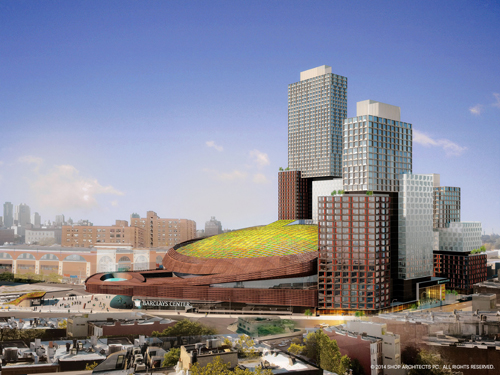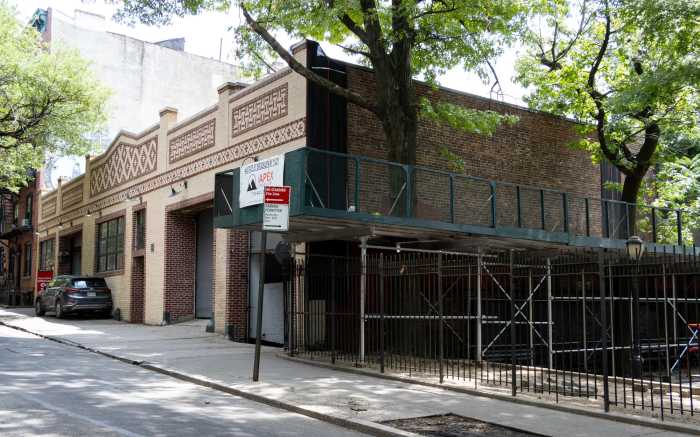Public Advocate Letitia James says that developer Forest City Ratner needs to hurry up and build Atlantic Yards before the surrounding area gets any richer and whiter.
The pol, who made her name as a Fort Greene councilwoman railing against the idea of the mega-development at Flatbush and Atlantic avenues, is now worried that the glacial pace of construction will mean that the so-called “affordable” apartments in the towers that could now be built as long as two decades from now will be far pricier than if they were finished today. That would mean the displacement of many in the middle class, predominately African-American neighborhood, James said.
“What I wanted then and what I want now is more affordable housing — to stem the tide of gentrification which is having an adverse impact on the balance, the racial composition, of Downtown Brooklyn,” James said an April 30 hearing on a new environmental impact report from the developer.
The remark was one of many from some of the same people who were demanding that Atlantic Yards not be allowed to rise an inch above the ground and are now calling on Forest City to build it as quickly as possible.
Delays of the mega-development at Flatbush and Atlantic avenues have pushed its expected completion date, which was originally supposed to be 2016, so far into the future that a court ruled an early study of the project’s impact on the surrounding neighborhood is no longer valid.
Original opponents of the project, where currently just the Barclays Center is completed and one of 15 planned high-rises are under construction, argue that the longer it takes, the more damage it does to the community. A revised study by Forest City leaves open the possibility that the project could take a whopping two more decades, wrapping up in 2035, which original project foes say is way too long because of the disruption the construction will cause and the assumption that the longer each tower takes to open its doors, the higher the cost of the next set of so-called “affordable” apartments will be.
“Unquestionably, this extended construction will put an unnecessary and unfair strain on the community,” James said at the hearing.
The developer blames legal opposition to the project for the delays and the global economic crisis that began in 2008 made matters worse, according to a rep.
“We were held up for years with lawsuits,” said Ashley Cotton, a spokeswoman for Forest City Ratner. “You can’t build when there’s threats of litigation. And then the financial crisis happened.”
The state Empire State Development Corporation, which approved the original plan for the project, okayed an updated version in 2009 that set a drop-dead date of 2025 for completion of the below-market-rate housing promised as part of a so-called “community benefits agreement.” After the update, a coalition of activist groups called Brooklyn Speaks filed another lawsuit claiming that the delays would have a detrimental impact on the surrounding neighborhoods because it would take longer for the cheap digs to be built and that the developer should be required to write up a new impact statement.
The courts agreed.
But the new study, released in March, found that extending the construction timeline even further to 2035 would not change what effect the gargantuan undertaking would have on neighbors.
The extended construction period, “would not result in significant adverse impacts due to indirect residential displacement,” the report states, without a hint of irony.
Activists say that is a bunch of hooey, arguing that the neighborhood is already changing and that the low-rent units are needed now, before the circa-2006 residents are totally pushed out.
“The people that were here when the project was first approved will have already been displaced by the time it’s completed,” said Michelle de la Uz, executive director of the Fifth Avenue Committee.
The argument is not purely speculative. The price of the below-market-rate rentals is tied to the neighborhood median income, which is rising with the completion of fancy residential skyscrapers Downtown and which new luxury apartments in each Atlantic Yards tower would drive up if they were completed piecemeal.
Brooklyn Speaks asked the state to hire multiple developers to get the building done faster, but Forest City’s new document argues that would not work because the project was approved with the company’s name on it.
“The FCRC affiliates’ existing rights under the numerous agreements they now have with the agencies would affect the feasibility of this alternative,” the report says. “The process required to implement the multiple developer alternative would be extremely time consuming, and its outcome would be uncertain.”
The developer apparently does not foresee any problems along those lines with the Chinese-government-owned company Greenland buying a seven-tenths stake in the complex.
“We see it as a total joint venture,” said Cotton. “We have the local knowledge and expertise. They can’t do it without us.”
Forest City Ratner insists it is doing all it can to get Atlantic Yards built as quickly as possible and that the 2035 date is purely hypothetical.
“Forest City is, and remains, fully committed to completing the Atlantic Yards projects as expeditiously as possible,” said Jane Marshall, a senior vice president at the company, at the hearing. “This 25-year outside date was never viewed by Forest City as a proposed construction schedule, but as a date by which we fail. We have always intended to complete the project much, much sooner than that.”
The mega-developer said that the cash it is getting from China is going to pick up the pace dramatically.
“The infusion of capital and the impatience of our partner is a huge shot in the arm,” Cotton said.
The company also notes that it hopes to break ground on three new buildings constituting 900 units within the next year. These buildings will be constructed using traditional methods, not the modular design the company has touted as a way to get things built faster, which it is using to build the 32-story B2 tower on Dean Street.
Company executives would not confirm that Forest City is seeking to sell its stake in the Brooklyn Nets Franchise, as reported by the Wall Street Journal.

























